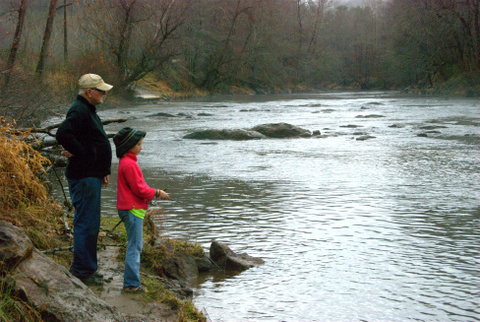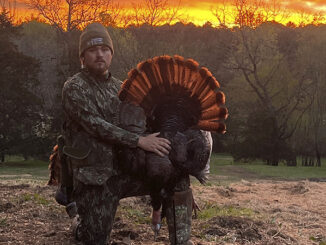
Delayed-harvest isn’t the only section to fish
On just about any day, fair weather or not, the delayed-harvest section of the Tuckasegee River in Jackson County is crowded with trout fishers, either wading or floating the stream. This 4.5-mile stretch of water is the queen of delayed-harvest waters. In the spring, in March to April and again in October and November, the N.C. Wildlife Resources Commission stocks 49,000 rainbow, brook and brown trout. Fishing guides love this section because they can almost guarantee that their clients will catch trout — a lot of trout.
The delayed-harvest section, however, is just a small portion of the river’s fishable waters. The rest of the stream, upstream and downstream, has fair to good populations of trout. The fishing is not as easy as it is on the delayed-harvest section, but an afternoon of fishing can usually yield a limit, and it’s not uncommon for that limit to include a few stream-born trout.
The lower section of hatchery-supported waters begins below the site of the old dam at Dillsboro and flows west to Swain County where it joins the Little Tennessee River and, ultimately, Fontana Reservoir. The river flows adjacent to US 441 to the Cherokee Indian Reservation exit and continues along US 19 all the way to Fontana. From the Barker’s Creek Access on US 441 to Bryson City, the river has a healthy smallmouth bass population as well as trout — good-sized trout. In the spring, walleye often make their spawning runs up the river.
On a recent, drizzly afternoon, I fished the lower section, entering the stream at the Barker’s Creek Access. Within an hour, I caught four trout. The smallest was an beautifully colored 11-inch brown trout, one that obviously had never seen a hatchery. The largest was a beautifully striped 14-inch rainbow trout. Due to high water levels, I chose to fish with a spinning rod rather than fly fish. This is big water, and when the water is up, as it was this day, it’s not safe to wade.
My family had not had a good trout dinner since late fall, so later that day, my granddaughter and I went to another section of the Tuckasegee at the Locust Creek Access on old Cullowhee Road. This section is just above the bridge on NC 107, where the delayed-harvest waters begin. The bonus of this area is that trout from the delayed-harvest waters don’t always stay where they are supposed to, and many of them work their way upstream to hatchery-supported waters.
Within 30 minutes, my granddaughter and I caught three rainbow trout, all stockers, enough for a feast of fresh trout.
End to end, the Tuckasegee River is approximately 52 miles long, beginning at the junction of Panthertown and Grassland creeks — both wild-trout streams — and flowing northwest through Jackson County into Swain County. All of the lower section below Dillsboro is big water. Some sections can be waded when water is not being generated, but because of limited bank access, much of the stream is limited to floating.
In the upper section, the river splits into the east and west forks at the Walter Middleton Bridge on NC 107 at the small community of Tuckasegee. The East Fork flows between NC 281 and Shook Cove Road. Access is good most of the way, and although the river runs through private property, only a few sections are posted. The Shook Cove Access Area is 1.5 miles upstream. The East Fork is downstream from Cedar Cliff and Bear Creek lakes.
The West Fork, a smaller stream, follows NC 107 to Tuckasegee Lake, a two-acre Duke Energy impoundment. The lake does contain trout, but access can be difficult, especially in the lower section. Above the lake, the river is more like a typical mountain stream with a rocky bed and high-gradient flow. This is also prime trout-fishing territory. A large, gravel parking area is near the power plant, and steps lead down to the stream. The stream is wadable and is open enough for fly fishing. Above Tuckasegee Falls, the stream enters posted property, but there’s plenty of fishable water before that.
Neither the East Fork nor the West Fork is stocked, but both sections contain adequate numbers of trout. Both streams are designated as general waters.
The Commission stocks both hatchery-supported sections of the Tuckasegee with approximately 10,000 rainbow, brook and brown trout between March and June. The upper section is stocked beginning at the junction of the east and west forks. The lower is stocked beginning below the old Dillsboro Dam to the small community of Wilmont.
The hatchery-supported sections have many streamside pull-off areas for parking. On Old Cullowhee Road is the Locust Creek Access. The East Laporte Recreation Area on NC 107 above Cullowhee recently was upgraded with additional parking spots and a river-access ramp. This section of the stream once produced a state-record brown trout, and it’s a popular fishing area for locals. A large pool below the access is especially productive.
When I want an enjoyable day of fly-fishing, I go to the delayed-harvest waters, but when I want an enjoyable day of fishing with the option of keeping enough trout for dinner, I head for the other sections of the Tuckasegee.





Be the first to comment